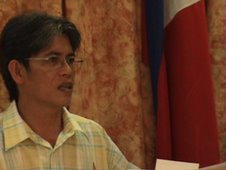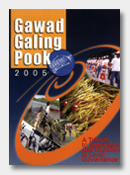 William Alama son of Fredo Alama and Grandson of Leonardo Alama at the rondalla exhibit hall in Silliman. At the background shows the photos of his grandfather and his employer Chico Tolin, a Dumaguete based banduria maker
William Alama son of Fredo Alama and Grandson of Leonardo Alama at the rondalla exhibit hall in Silliman. At the background shows the photos of his grandfather and his employer Chico Tolin, a Dumaguete based banduria maker Remedios Alama, wife of Leonardo Alama and their Tugawe made
Remedios Alama, wife of Leonardo Alama and their Tugawe made  Proudly made in Barangay Tugawe, Municipality of Dauin
Proudly made in Barangay Tugawe, Municipality of Dauin
 the buyer is the conductor of the Sta. Rita de Cascia Rondalla of Angat Bulacan, was very impressed with the distinct tone of the banjo handcrafted by Leonardo Alama
the buyer is the conductor of the Sta. Rita de Cascia Rondalla of Angat Bulacan, was very impressed with the distinct tone of the banjo handcrafted by Leonardo Alama Leonardo Alama interviewed by the ABS-CBN Cebu talk show host
Leonardo Alama interviewed by the ABS-CBN Cebu talk show host Jude of the Jud Morning Show
 Exhibit banner at the entrance of Silliman Hall where the exhibit was held
Exhibit banner at the entrance of Silliman Hall where the exhibit was held Felix Alama at the rehearsal in the main convention hall of the Provincial Convention Center
Felix Alama at the rehearsal in the main convention hall of the Provincial Convention Center Felix Alama poses infront of their picture at the exhibit hall
Felix Alama poses infront of their picture at the exhibit hall







1 comment:
bilib ako s ako silingan na si Nardo Alama or Alamas family,maayo muhimo ug balay siya ang naghimo sa balay namo,sundang,ug bisag unsa nga klase n gitara,SIKAT SA RONDALLA SA TIBOOK KALIBUTAN ug ang iyang asawa na si meding nindot pod mukanta kauban namo sa CCFC saona.dugay na ako wala p nakauli diha sa tugawe,pero bisan unsag ka dugay na naa pa gihapon sa yuta nga akong gitawhan,dako kaayo ko pasalamat kay Mayor Rodrigo Alanano.karon ug unya ang Dauin naimprove na,maraming salamat Mayor,God BLess
Post a Comment